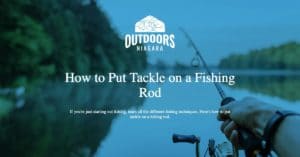If you are shopping for a new fishing pole, you have no doubt seen telescopic fishing rods.
These are a popular option for anyone who fishes and prefers portable fishing rods.
Keep reading as we explore the ins and outs of collapsible fishing rods.
Contents
What Are Telescopic Fishing Rods?
Telescopic fishing rods are collapsible fishing poles.
Instead of coming apart in sections as a traditional fishing rod may do, the sections on a telescopic rod nest inside each other.
The collapsed unit is compact and easy to carry, especially if you have to hike into a fishing spot that is brushy if traveling by plane.
What Is a Telescopic Fishing Rod Used for?
Telescopic fishing rods are ideal for fishing situations where you need a medium- to light-weight rod with moderate to slow action.
Telescopic fishing rods are suitable for fishing ponds, small rivers, and even near-shore saltwater.
It is essential to ensure that the rod you choose is rated for saltwater, as saltwater can cause the eyes to rust if they are not sealed.
A good tip is to choose a rod with stainless steel eyes.
How Does a Telescoping Fishing Rod Work?
In terms of fishing, a telescoping fishing rod works the same as other types of fishing rods.
The length of the rod determines the distance of your cast and the weight of the lure.
However, in terms of extending and collapsing a telescopic fishing rod, the process is easy.
To extend, hold the rod by the handle and gently pull on the rod section closest to the handle until you extend it fully.
As the unit becomes harder to pull, give it a slight twisting action to tighten it fully.
Please do not overdo it, or you can break the rod.
Because each section tapers, you will feel it tighten. When that happens, move to the next section.
Continue until the rod you have all of the sections or blanks extended.
Double-check that the rod’s eyes or line guides are aligned so that the line does not bind when casting or jigging.
Of course, ceramic guides allow for smoother casting.
The parts of a telescoping fishing rod include:
- The handle and reel seat
- The units of the rod can range from two-five, sometimes more
- Metal eyes of line guides
- A spinning reel
What Are Telescopic Rods Made of?
Telescoping fishing rod manufacturing occurs from many common material, including:
- Graphite rods
- Fiberglass rods
- And carbon rods
The parts of a traditional fishing rod include the handle and the blanks.
Blanks are the sections of the rod. Some traditional Fishing rods have only one blank, and some break down into several pieces.
With a telescoping fishing rod, the blanks are hollow so that they nest when collapsed.
Do Telescopic Fishing Rods Break Easily?
Any fishing rod may break if proper care is not taken.
However, when it comes to telescoping fishing rods, they have more opportunities to break than traditional rods.
What we mean is that under regular wear-and-tear, telescopic fishing rods deal with more stress.
The biggest problem is the nesting function of the rod blanks.
These can wear down over time, making the blank fit less pristine than when new.
Also, because of the rod’s blank nest, they rattle, and that added vibration can cause damage to the blanks and the pole’s eyes.
Another issue that can cause damage to a telescoping fishing rod is that grit or gravel can become lodged in the cup where the blanks nest.
Like any other type of fishing rod, if you target fish that are too large, the rod can break.
Also, if the rod is not a saltwater rod, the eyes can rust and cause line damage.
Like any other type of fishing rod, if you target larger fish, the rod can break.
Also, if the rod is not a saltwater rod, the eyes can rust and cause line and guide breakages.
Other than these issues with non-freshwater fishing, a telescoping fishing rod is durable.
Is a Telescopic Fishing Rod Good?
You should experience no difference in fishing quality with a telescoping fishing rod than you would with any other rod type because fishing rods are tools, and there is a suitable tool for every job.
When it comes to fishing, the primary benefit of a telescoping fishing rod is that it collapses into a small size, making it an excellent tool for anyone who backpacks, hikes, or travels into remote fishing spots.
You want to match your fishing targets to the fishing rod that you use.
Smaller fish are ideal, such a brook trout, panfish, bluegill, bass, arctic grayling, and even small salmon fishing, such as pink salmon.
Most telescoping fishing poles are medium-lightweight with a medium-slow action.
Is a Telescopic Rod Worth It?
A telescopic fishing rod is worth the investment.
So long as you use the pole as intended, you should have very few problems with it.
However, it is essential to understand the physical fishing conditions, the fish available to target, and the weather conditions in which you will fish.
If you love remote fishing spots where a mile or so hike in is standard, then you will love the telescoping fishing rods because they are easy to stuff into a backpack.
If you are deep-sea fishing for Shark, Tuna, or Cobia, you will likely not enjoy the telescoping fishing rod as the conditions, fish, and weather can overwhelm the structural build of these rods.
Use the best tool for the job.
Why Are Telescopic Rods Bad?
Telescoping fishing rods are not bad, so long as you use them in the way their design merits.
That means sticking to smaller fish and fishing conditions where a medium-lightweight rod is a perfect tool for that job.
If you care for the rod as you would for any other tool, it will last and be available when you need it.
However, if you lay it in the dirt, expect that grit or sand will get into the joints, and that can cause the rod to become stuck in the extended position.
It’s important to make sure the sections are lined and locked up or they can slip into each other.
Conclusion
If you need a fishing rod that is easy to take with you when you travel, hike, backpack, or camp, then a telescoping fishing rod can be an excellent choice.
It can be a great choice for an experienced angler or novice anglers alike.
They are easy to tuck behind the seat or leave in the trunk so that you can fish without planning.
With any fishing rod, match the rod to the fishing style, and you are good to go.







